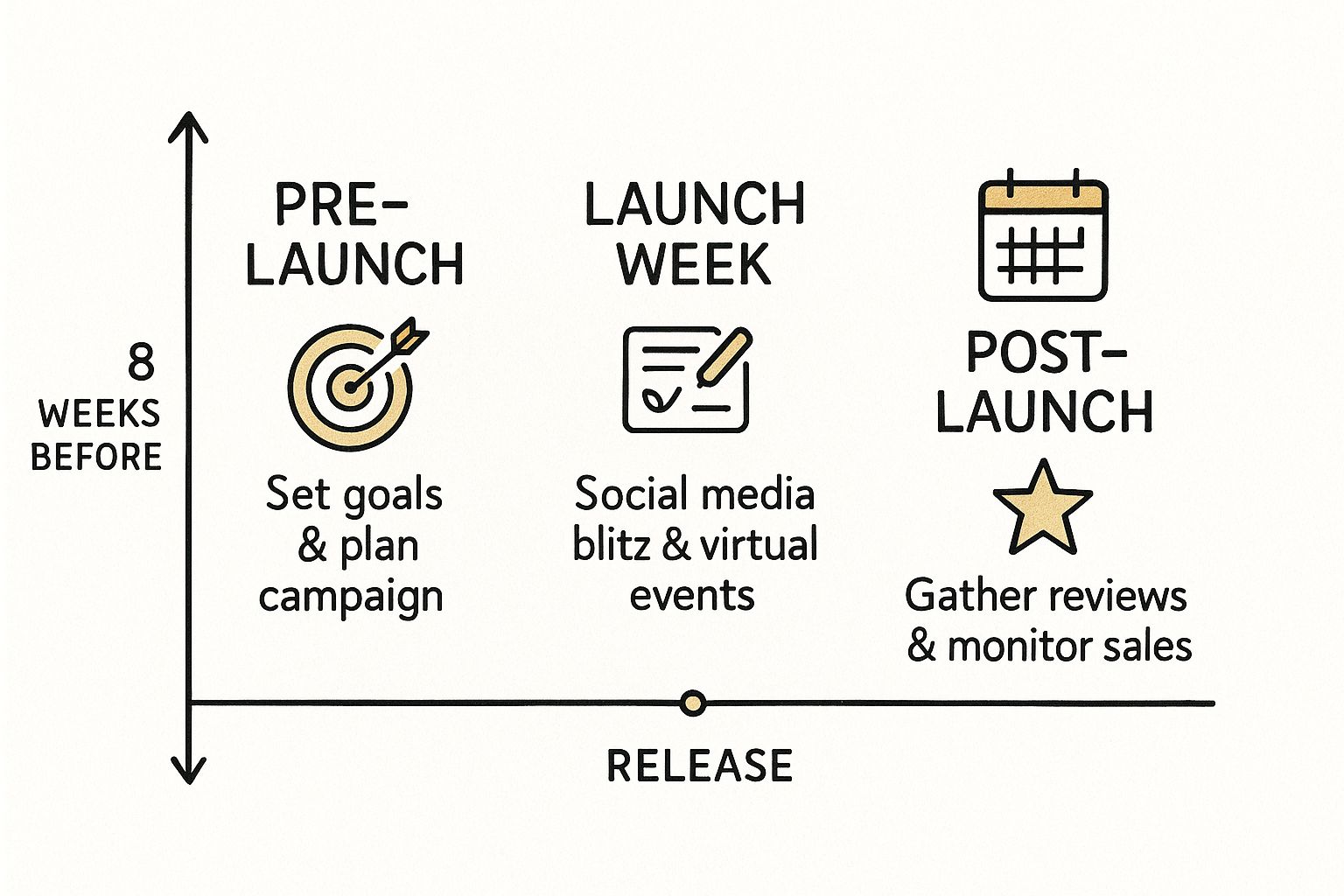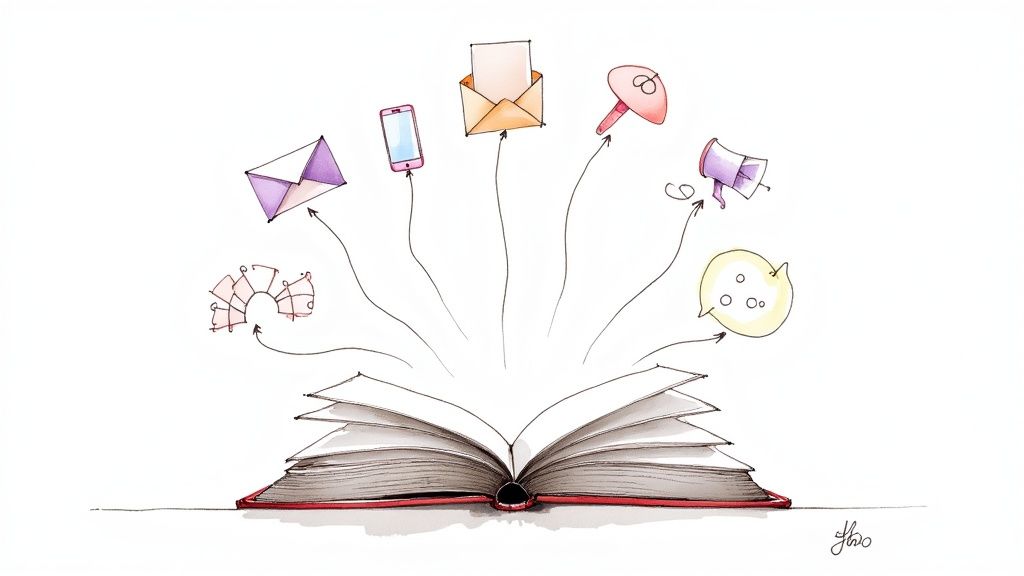Book Marketing for Self-Published Authors Demystified

Let's be honest: effective book marketing, especially when you're a self-published author, isn't about just tossing things out there and hoping something sticks. The authors who truly succeed are the ones who play the long game. They build a solid foundation long before they even think about spending a dollar on ads.
It all starts with strategically defining who your book is for, positioning it perfectly in the market, and setting crystal-clear goals right from the get-go.
Laying the Groundwork for Your Book's Success

So many authors make the mistake of thinking that marketing begins on launch day. The reality? It starts the moment you have a solid draft. This pre-launch phase is your golden opportunity to build the framework that will support everything else you do—from social media campaigns to your big launch day blitz.
Skipping this foundational work is like building a house on sand. It might look okay for a little while, but it's simply not going to hold up in today's crowded market. And believe me, it's crowded. The number of self-published books with ISBNs jumped by 7.2% from 2022 to 2023, soaring past 2.6 million titles for the year. That's a lot of competition, which makes being strategic more critical than ever.
Who Is Your Ideal Reader? Get Specific.
Before you can sell your book, you have to know exactly who you're selling it to. This is the absolute first step, and it's all about figuring out how to find your target audience with real precision. A vague description like "women aged 25-55 who like thrillers" just won't cut it anymore. You need to create a detailed reader persona that feels like a real person.
Give your ideal reader a name. A job. Hobbies. Maybe even a favorite coffee shop. Ask yourself:
- What blogs or websites do they visit daily?
- Which podcasts are always in their queue?
- Where do they spend their time on social media? Is it TikTok, Instagram, or a niche Facebook group?
- Who are their "auto-buy" authors?
Answering these questions gives you a roadmap. If your perfect reader is a 35-year-old history fanatic who never misses an episode of "Hardcore History," you immediately know that blowing your budget on a pop-culture TikTok ad is a total waste of time and money.
Analyze Your "Competition" (AKA Your Future Colleagues)
Once you know your reader, you need to find out what they're already buying and loving. This involves analyzing "comp titles"—books that are similar to yours in genre, tone, and theme. This isn't about copying other authors; it’s about reverse-engineering what’s already proven to work.
Pick 3-5 successful indie authors in your specific niche. Go deep. Study their book covers. Read their blurbs—and then read them again. See which Amazon categories and keywords they're using to get discovered. This research reveals powerful patterns that tell you exactly what your shared audience responds to. You'll quickly see what kind of cover art screams "epic fantasy" versus "cozy mystery," or what style of book description is a magnet for psychological thriller fans.
Before you even launch, you need to nail down these foundational elements. Think of it as a pre-flight check for your book's marketing.
Here’s a quick checklist to make sure you have your core marketing foundation in place:
Core Marketing Foundation Checklist
| Element | Key Objective | Example Action |
|---|---|---|
| Reader Persona | To create a hyper-specific profile of your ideal buyer. | Name your reader "Alex," a 30-year-old software dev who loves sci-fi podcasts and follows tech blogs. |
| Comp Title Analysis | To understand market expectations for your genre. | Analyze the cover design, blurb structure, and keywords of 3 top-selling space opera indie books. |
| Unique Selling Proposition (USP) | To define what makes your book stand out. | "My book is Dune meets The Godfather, a political thriller set on a desert planet." |
| Book Cover | To visually communicate genre and attract the right readers. | Hire a designer who specializes in paranormal romance to create a cover with genre-appropriate fonts and imagery. |
| Book Blurb | To hook the reader and convince them to buy. | Write a compelling, punchy blurb that starts with a hook, introduces conflict, and ends on a cliffhanger. |
| Keywords & Categories | To maximize discoverability on retail platforms like Amazon. | Research and select 7 specific Amazon keywords and 2 niche categories where your book can rank. |
Getting these pieces right from the start will save you countless hours and dollars down the road. It's the difference between a launch that fizzles and one that finds its audience.
What Makes Your Book Unforgettable? Craft Your USP.
In a market flooded with millions of options, just saying "buy my book" is a surefire way to be ignored. You need a Unique Selling Proposition (USP). This is a short, powerful statement that tells readers exactly what makes your book different and why they should pick it over all the others.
Your USP should immediately answer the question: "What does this book give me that I can't get elsewhere?"
- Is it a fresh mash-up of genres (e.g., a historical fantasy set during the Jazz Age)?
- Is your protagonist completely unexpected (e.g., a grandma who's also a master assassin)?
- Do you put a clever twist on a beloved trope (e.g., a chosen one who wants nothing to do with their destiny)?
For instance, a great USP for a fantasy novel could be: "It's The Lord of the Rings meets Peaky Blinders, where rival elven gangs battle for control over a magical, industrial city." That one sentence is instantly memorable. It communicates the book's tone and concept, making it absolutely irresistible to the right kind of reader.
How to Build an Unforgettable Author Platform
Your author platform isn't just a website or a social media profile. Think of it as the digital home you build for your readers—a place where you can connect with them directly, away from the chaos of retailer algorithms and fleeting social media trends. Solid book marketing for self-published authors really comes down to building this foundation, one that turns casual readers into a loyal community.
Imagine your books are the products you’ve poured your heart into. Your platform is the storefront. Without a well-lit, inviting storefront, even the most brilliant products will just sit on the shelf. A strong platform is your single most powerful, long-term marketing tool. It’s what ensures you have an engaged audience genuinely excited for whatever you write next.
Your Website Is Your Central Hub
Every author needs a professional website. Seriously, this isn't optional anymore; it's the anchor for everything you do online. It's the one piece of internet real estate you truly own and control. Social media is fantastic for reaching new people, but your website is where you want to send them—it's where you build your brand and, most importantly, capture leads.
Your site doesn't need to be flashy or complicated, but it absolutely must look professional and have a clear purpose. The moment someone lands on it, they should know exactly who you are, what kind of books you write, and why they should care.
At a bare minimum, your author website must have these three things:
- A Compelling Bio: Don't just list your credentials. Tell your story in a way that resonates with your ideal reader. If you’re a former detective writing crime thrillers, lead with that! It builds immediate authenticity and makes you memorable.
- Detailed Book Pages: Give each book its own dedicated page. You'll want a high-resolution cover image, a blurb that hooks the reader, and obvious, easy-to-find buy links for all the major online stores. If you have a great review or some early praise, feature it prominently.
- An Easy-to-Find Email Signup: This is critical. Your newsletter signup form should be impossible to miss. Put it on your homepage, at the end of blog posts, and maybe even in your site's footer.
An author’s platform is less about shouting into the void and more about creating a welcoming space where readers want to gather. It’s a shift from broadcasting to community building.
Grow Your Most Valuable Asset: Your Email List
Let me be clear: your email list is the most important part of your author platform. It’s a direct line to your readers that you own. You're not at the mercy of an algorithm deciding who sees your posts. An engaged list of 1,000 true fans is infinitely more valuable than 10,000 passive followers on any social media platform.
The trick to growing your list is to offer something valuable in exchange for an email address. We call this a lead magnet, and it needs to be irresistible to your target reader.
For a fiction author, a killer lead magnet could be:
- A Prequel Novella: Give new subscribers a short story that fleshes out a main character’s backstory or sets the stage for your series.
- A Deleted Scene: Offer an exclusive look at a juicy scene that didn’t make the final cut. Fans love getting a peek behind the curtain.
- The First Three Chapters: Let readers sample your writing to get them hooked. If they love the first few chapters, they'll be eager to buy the rest of the story.
If you write non-fiction, you could offer a handy checklist, a practical worksheet, or a short ebook that solves a specific problem for your audience. The goal is simple: provide something so good that your ideal reader is happy to trade their email for it.
Create Content That Connects and Converts
A static platform is a dead platform. You need to keep it alive with fresh content that pulls readers in. This content does two jobs: it attracts new people who find you through search or social media, and it deepens the relationship you have with your existing audience.
While many authors lean on social media, remember that it's just one tool in your toolbox, not the whole strategy. For a ton of great ideas, check out our in-depth guide to social media for authors.
Blogging for Authors
Your blog is the perfect spot to let your expertise and personality shine. Writing historical fiction? Blog about the fascinating, little-known historical details you uncover during your research. Writing self-help? Share actionable tips that give people a taste of the value they'll find in your full book.
Personal Social Media Updates
Please, don't just post "buy my book" over and over. Share the journey. Talk about the weird research rabbit hole you fell down last night. Post a picture of your messy desk or your snoozing pet. These personal glimpses are what build a real connection and make readers feel like they actually know you.
This is how you build a platform that doesn't just sell books, but fosters a community of true fans who will champion your work for years to come.
Turning Subscribers into Superfans with Email

Social media is fantastic for getting discovered, but your email list? That's where you forge real, lasting relationships with readers. This isn't just a list of names; it's a direct, unfiltered line to your most passionate fans. Honestly, if there's one thing that separates authors who build a career from those who don't, it’s mastering the art of turning subscribers into a loyal community.
Think about it. A social media post is like shouting in a crowded park, hoping the right people happen to walk by. An email is like sitting down for a one-on-one coffee with a reader. It’s personal, direct, and incredibly powerful. Because you own your list, it's your single most valuable marketing asset.
The Automated Welcome Sequence: Your Secret Weapon
The moment someone signs up is pure gold. They're interested, engaged, and curious about you. Don't let that precious momentum fizzle out. This is where an automated welcome sequence comes in—it’s a series of pre-written emails that rolls out the red carpet for every new subscriber.
This sequence is a true game-changer. It works for you 24/7, ensuring every new reader gets the same warm, strategic introduction to your world. For a fiction author, it might look something like this:
- Email 1 (Immediately): The instant they sign up, deliver the promised lead magnet (like that prequel novella) along with a genuine, personal welcome.
- Email 2 (2 Days Later): Share a fun "behind-the-scenes" story about your writing process or a bit of trivia related to the freebie they just read.
- Email 3 (4 Days Later): Gently introduce your backlist. You could talk about your most popular book and explain why someone who liked the free story will probably love it.
- Email 4 (7 Days Later): Ask a question to spark a conversation. Something like, "What kind of character would you love to see in my next book?" This makes them feel heard and valued.
This simple, automated series does the heavy lifting of building rapport, skilfully guiding a new subscriber from being mildly curious to becoming an invested fan.
Crafting Emails People Actually Want to Open
Let's face it: inboxes are a battlefield. The biggest challenge we have is cutting through all that noise. To make sure your emails get seen, you have to learn how to craft compelling email subject lines that pique curiosity.
But a great subject line is only half the battle. Once they open it, the content has to deliver. A truly effective author newsletter strikes a delicate balance between promotion and connection. I always follow the 80/20 rule: 80% of what I send is valuable, entertaining, or personal, while only 20% is a direct sales pitch.
Your email list is not just a sales channel; it's a community hub. When you treat your subscribers like valued insiders, they become your most powerful advocates, helping to drive reviews, buzz, and long-term sales.
For example, a mystery author could send an email detailing the fascinating real-life cold case that sparked their latest plot. This provides incredible value and context, making the eventual "buy my book" email feel completely natural and earned. It's a strategy that works, because engaged readers are buying. U.S. print sales hit 782 million units in 2024, and global ebook sales are projected to top $14.92 billion in 2025. People are reading across all formats.
Using Your List for Powerful Launches
When your new book is ready, your email list becomes your launch team. These are the people most likely to buy on day one, leave those critical early reviews, and tell their friends. They are your street team, your hype crew, and your biggest supporters all rolled into one.
Here’s how you can rally them for a huge launch:
- ARC Team Recruitment: Before you go public, offer spots on your Advance Reader Copy (ARC) team exclusively to your list.
- Cover Reveals: Make them feel like VIPs by giving them the very first look at your new cover.
- Launch Day Blitz: On release day, send out a coordinated "it's live!" email. Encourage them to buy and share, because that initial surge of sales can rocket your book up the retailer charts.
By consistently nurturing your email list with great content, you aren't just building an audience—you're cultivating a dedicated fanbase that will be the bedrock of your entire author career.
Smart Social Media and Advertising Strategies

Diving into social media and paid ads can feel like trying to drink from a firehose. With so many platforms and strategies out there, it's easy for a self-published author to feel completely overwhelmed. But I'll let you in on a little secret: you don't have to be everywhere. You just need to show up where your readers already are.
Think of social media and advertising as your direct line to people actively hunting for their next great read. Your goal isn't to just shout into the void; it's to start meaningful conversations with the right people. This is the heart and soul of effective book marketing for self-published authors.
Choose Your Platforms Wisely
First things first: stop trying to master every single social media platform. It’s a surefire recipe for burnout and a total waste of your precious time. Instead, pour your energy into the one or two places where your ideal reader hangs out.
For example, if you write historical fiction, you’ll probably find a passionate and engaged community in niche Facebook groups or on Instagram, where you can use striking historical images to draw people in. A YA fantasy author, on the other hand, will almost certainly find their tribe in the vibrant #BookTok community on TikTok.
Just look at the numbers. Self-publishing has exploded, seeing a 264% increase over the last five years. In 2023 alone, around 500,000 new self-published books hit the shelves in the U.S. With romance making up 40% of all self-published books on Amazon, can a romance author really afford to ignore a platform like TikTok? That's where their readers are.
Create Content That Captivates Readers
Once you’ve staked your claim on a platform or two, it’s all about what you post. Generic "buy my book!" posts are the fastest way to get ignored or, worse, unfollowed. Your content needs to offer value, provide a little entertainment, or forge a genuine connection.
Here are a few ideas that work wonders, no matter the platform:
- Behind-the-Scenes Peeks: Snap a photo of your messy writing desk, share a screenshot of a fascinating research rabbit hole, or film a quick video talking about a character who drove you crazy. It makes you human.
- Thematic Content: If your thriller is set in Alaska, share some wild facts about the Alaskan wilderness or dive into famous unsolved mysteries from the area. This naturally attracts people interested in your book’s setting and mood.
- Ask Engaging Questions: Don't just talk at your followers. Ask them things like, "If you could have dinner with one of my characters, who would it be and why?" This sparks real conversation and makes people feel involved.
- Embrace User-Generated Content: When a reader posts a gorgeous photo of your book, share it! This gives you great content and, more importantly, celebrates your fans, encouraging others to do the same.
The best social media marketing for authors isn't about selling a product. It's about inviting readers into your story's world. Make them feel like part of the journey, and they'll become your most passionate advocates.
A Beginner's Guide to Paid Ads
Paid advertising, especially on Amazon and Facebook, is an incredible tool for putting your book directly in front of active buyers. It doesn't replace your organic efforts—it supercharges them. The trick is to start small, test everything, and target with laser-like precision.
If you're looking to really understand the mechanics behind this, a good guide to lead generation advertising can provide a solid foundation.
Setting a Realistic Budget
You don't need a massive budget to get started. Many successful authors kick things off with just $5 to $10 per day. The initial goal isn't to sell thousands of books; it's to gather data. You’re paying to learn which ad copy, images, and audiences work before you even think about scaling up.
Targeting the Right Readers
This is where the magic of ads happens. Both Amazon and Facebook give you incredibly detailed targeting options.
- On Amazon Ads: You can target readers who've bought books by your "comp" authors. If your sci-fi novel has Andy Weir vibes, you can run an ad that shows up right on the product page for The Martian.
- On Facebook Ads: You can build audiences based on specific interests. For example, you could target users who like "Science Fiction," "Space Opera," and authors like Blake Crouch or Dennis E. Taylor. Layering interests like this gets your ad in front of a hyper-relevant audience.
Simple Ad Creative That Converts
Your ad doesn't need to be a masterpiece of graphic design. In fact, some of the most effective book ads are deceptively simple: a clean image of your book cover paired with a killer hook.
Keep your ad copy short and punchy. Lead with a compelling line from your book's blurb, a powerful snippet from a review, or a question that sparks curiosity. For a thriller, you might try something like: "They thought he was the perfect husband. They were dead wrong." That’s far more intriguing than just listing the title and price.
By focusing your efforts on a few key platforms and taking a data-driven approach to ads, you can cut through all the noise and connect directly with readers who are eager to discover you.
Executing a High-Impact Book Launch
A great book launch isn't just about flipping a switch on publication day. It’s a full-blown campaign, carefully orchestrated to build a massive wave of excitement. This is where all your hard work—getting to know your audience, building your author platform, and connecting with your email list—truly pays off. For self-published authors, effective book marketing is about turning your release into an event people can't ignore.
The real goal here is to create a concentrated burst of activity. This initial surge tells retailer algorithms, especially Amazon's, that your book is a hot commodity. That's what gets you climbing the sales charts, catching eyes, and pulling in a whole new crowd of organic readers.
This infographic lays out the whole process, from the early prep work to keeping the momentum going long after launch day.

As you can see, a successful launch happens in phases. Each one has its own set of tasks designed to build on the last and keep your book in the spotlight.
Building Your ARC Team for Early Buzz
One of the most powerful things you can do before you launch is put together an ARC (Advance Reader Copy) team. This is your hand-picked crew of readers who get a free, early version of your book. Their mission? To leave an honest review on or right after launch day. Trust me, those first reviews are pure gold.
They offer vital social proof for readers who are still on the fence. Landing on a book page with zero reviews is like walking into an empty store—it just feels off. But a page with even a handful of honest reviews instantly builds credibility.
So, where do you find these people? Start with your biggest supporters:
- Your Email List: These are your people. Send them an exclusive invitation—they're the most likely to be thrilled to help out.
- Social Media Followers: Put out a call on your social channels, inviting your most engaged followers to apply.
- Book Review Hubs: You can also check out platforms like BookSprout, which connects indie authors with reviewers who are actively looking for their next read.
Your aim should be to gather a team that can realistically get you 10-20 reviews in that critical first week. Just be sure to give them clear instructions and a friendly nudge as the big day gets closer.
To keep everything straight, a simple timeline can be a lifesaver. It helps you visualize what needs to happen and when, ensuring no crucial step gets missed in the pre-launch chaos or post-launch buzz.
Book Launch Promotion Timeline
| Phase | Timeframe | Key Activities |
|---|---|---|
| Pre-Launch | 4-6 Weeks Before | Assemble ARC team, schedule emails, prepare social media content, set up ads. |
| Launch Week | Days 1-7 | Send "It's Live!" email, execute social media blitz, run targeted ads, monitor reviews. |
| Post-Launch | 2-4 Weeks After | Thank your ARC team, share reader photos/reviews, analyze ad performance, plan ongoing promos. |
Mapping out your activities like this transforms a potentially overwhelming process into a manageable set of tasks. It's all about strategic execution from start to finish.
Coordinating Your Launch Week Promotional Blitz
Launch week is showtime. This is when you go all-out. It’s time to be loud, proud, and everywhere your readers hang out. The secret sauce is coordination—every email, post, and ad should work together to funnel people straight to your book's sales page.
Your launch is the payoff for months of effort. Treat it like the major event it is. By creating a concentrated "blitz" of activity, you generate the initial sales velocity needed to trigger retailer algorithms and attract new readers.
Here’s what your launch week could look like:
- The Big Email: On launch day, send a "It's Live!" announcement to your entire email list. A few days later, follow up with a gentle reminder, maybe sharing a fantastic early review to add some excitement.
- Social Media Saturation: Plan a full week of content. Post your cover reveal, share some behind-the-scenes stories, and showcase snippets of your best reviews as they start rolling in. Using a consistent hashtag helps tie everything together.
- Strategic Ad Spend: If you're running ads, launch week is prime time. Point your budget toward readers of your comp authors to connect with buyers who are already looking for a book like yours.
For a deeper look at promotional tactics to really make some noise, you can find more great advice on how to promote a self-published book and keep the momentum going.
A Smart Launch Pricing Strategy
Your price can be a surprisingly powerful marketing tool. Many indie authors have seen huge success by offering a special launch discount. Pricing your new ebook at $0.99 or $1.99 for the first few days can be an irresistible offer for readers discovering you for the first time.
This isn't about devaluing your book; it's a calculated move to drive a high volume of initial sales. More sales, even at a lower price, send a powerful signal to Amazon's recommendation engine. This can get your book featured in "Hot New Releases" and "Also Boughts," which leads to more full-price sales down the line.
After the initial launch sale (usually 3-7 days), you can raise the price to its permanent home. Your early adopters get a great deal for supporting you, and you get the sales velocity you need for a blockbuster launch. It’s a classic win-win.
Frequently Asked Author Marketing Questions
When you're trying to promote your own book, it's easy to get lost in the weeds. A lot of the same questions pop up time and time again from authors just like you. Let's tackle some of the biggest ones head-on so you can move forward with confidence.
Getting clear, practical answers to these fundamental questions can genuinely change the game for your book's success.
How Much Should I Budget for Book Marketing?
There’s no magic number here, but let's reframe the question. Instead of thinking of it as a cost, think of it as an investment in your book's future.
For most indie authors just starting out, a budget of $500 to $2,000 for a new launch is a realistic and effective range. That money isn't just for ads; it's for building a professional, marketable product from the ground up.
So, where does that money go?
- A Killer Cover Design: This is absolutely non-negotiable. Expect to spend $300 to $800 for a designer who understands your genre and creates something that grabs attention.
- Professional Editing: While it feels like part of the writing process, think of it as the first step in marketing. A polished book is a sellable book.
- Advertising: You don't need a massive ad budget to start. Setting aside $5-$10 per day for Amazon Ads or Facebook Ads lets you test what works without breaking the bank.
- Promotional Tools: This covers things like your email newsletter service or submitting your book to promo sites.
The goal isn't to spend the most; it's to spend the smartest. A small, focused budget that hits the right audience will always beat a huge, scattergun approach.
Start small, see what gets you sales, and then reinvest your profits back into the things that are working. Marketing is a long game.
When Is the Best Time to Start Promoting a Book?
Much, much earlier than you probably think. For a book launch to really land with a splash, you need a runway. I always tell authors to start laying the groundwork at least 3 to 6 months before your release date.
This pre-launch window is pure gold. It's your chance to build a genuine buzz and gather a crowd of readers who are excited to buy your book the moment it goes live.
During these months, you should be focused on:
- Growing Your Email List: Create a great freebie—like a prequel short story or a character guide—to entice your ideal readers to sign up.
- Getting Active on Social Media: This isn't about spamming "buy my book!" It's about sharing behind-the-scenes glimpses of your writing life and talking about the themes that fuel your story.
- Building an ARC Team: Find a group of dedicated readers willing to receive an Advanced Reader Copy (ARC) in exchange for an honest review on launch day. Those early reviews are critical.
When you start early, your launch day isn't a starting line; it's the exciting culmination of a months-long campaign. For a deeper dive into creating this timeline, our complete guide on how to promote a self-published book lays it all out.
Do I Really Need to Be on Every Social Media Platform?
No. And please, don't even try. Spreading yourself across every platform is the fastest way to burn out and feel like your marketing is going nowhere. You'll be stretched so thin that you won't make a real connection anywhere.
The smart move is to be strategic. Figure out where your specific readers hang out online and go there. Just pick one or two platforms and focus on doing them well.
For instance, if you write steamy romance or YA fantasy, you need to be on TikTok and Instagram. If you write thrillers, a Facebook author page and reader group could be your sweet spot. For business nonfiction, LinkedIn is probably a much better bet.
It’s far more powerful to build a real community in one or two key places than it is to shout into the void on a dozen different apps.
Feeling overwhelmed with all the marketing assets you need to create? ManuscriptReport.com can help. Our AI-powered tool generates a full-stack marketing report for your book in about 10 minutes, including blurbs, ad copy, social media posts, and more. See how fantasy authors Ross & Deborah went from "no idea what they were doing" to confidently marketing 7 books using ManuscriptReport as their marketing foundation. For a comprehensive comparison of budget-friendly promotion options, check out our guide to affordable book marketing services that includes ManuscriptReport and 10 other cost-effective solutions for indie authors. Spend less time on marketing and more time writing your next book by visiting ManuscriptReport.com.
Related Articles

AI Book Marketing: 7 Proven Tactics + Best Tools Guide (2025)
Master AI book marketing with 7 proven tactics, top tool recommendations, and strategic insights. Boost visibility, automate campaigns, and increase book sales effectively.

Top Affordable Book Marketing Services for Authors 2026
Explore our list of affordable book marketing services to help authors boost visibility and sales without breaking the bank. Find your ideal option today!

Effective Content Distribution Strategies to Boost Visibility
Learn top content distribution strategies to increase your book's reach. Discover how to leverage media channels for maximum exposure.